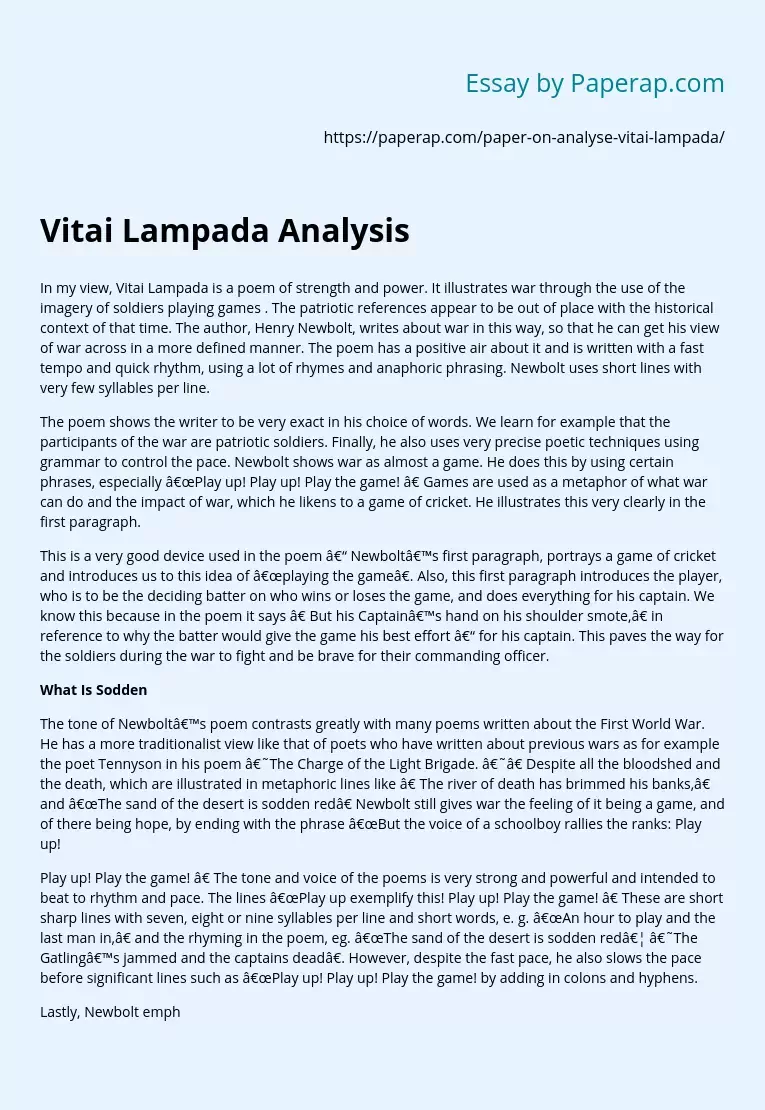In my view, Vitai Lampada is a poem of strength and power. It illustrates war through the use of the imagery of soldiers playing games . The patriotic references appear to be out of place with the historical context of that time. The author, Henry Newbolt, writes about war in this way, so that he can get his view of war across in a more defined manner. The poem has a positive air about it and is written with a fast tempo and quick rhythm, using a lot of rhymes and anaphoric phrasing.
Newbolt uses short lines with very few syllables per line.
The poem shows the writer to be very exact in his choice of words. We learn for example that the participants of the war are patriotic soldiers. Finally, he also uses very precise poetic techniques using grammar to control the pace. Newbolt shows war as almost a game. He does this by using certain phrases, especially “Play up! Play up! Play the game! ” Games are used as a metaphor of what war can do and the impact of war, which he likens to a game of cricket.
He illustrates this very clearly in the first paragraph.
This is a very good device used in the poem – Newbolt’s first paragraph, portrays a game of cricket and introduces us to this idea of “playing the game”. Also, this first paragraph introduces the player, who is to be the deciding batter on who wins or loses the game, and does everything for his captain.
We know this because in the poem it says ” But his Captain’s hand on his shoulder smote,” in reference to why the batter would give the game his best effort – for his captain. This paves the way for the soldiers during the war to fight and be brave for their commanding officer.
What Is Sodden
The tone of Newbolt’s poem contrasts greatly with many poems written about the First World War. He has a more traditionalist view like that of poets who have written about previous wars as for example the poet Tennyson in his poem ‘The Charge of the Light Brigade. ‘” Despite all the bloodshed and the death, which are illustrated in metaphoric lines like ” The river of death has brimmed his banks,” and “The sand of the desert is sodden red” Newbolt still gives war the feeling of it being a game, and of there being hope, by ending with the phrase “But the voice of a schoolboy rallies the ranks: Play up!
Play up! Play the game! ” The tone and voice of the poems is very strong and powerful and intended to beat to rhythm and pace. The lines “Play up exemplify this! Play up! Play the game! ” These are short sharp lines with seven, eight or nine syllables per line and short words, e. g. “An hour to play and the last man in,” and the rhyming in the poem, eg. “The sand of the desert is sodden red… ‘The Gatling’s jammed and the captains dead”. However, despite the fast pace, he also slows the pace before significant lines such as “Play up! Play up! Play the game! by adding in colons and hyphens.
Lastly, Newbolt emphasizes the patriotic fervour of the soldiers by his word use, e. g. “This they all with a joyful mind, Bear through it like a torch in flame,” – joyful adds to the game idea and a torch of flame signifies power, strength might etc … as it was commonly used in medieval battles and has been recreated especially well in ” the Lord of the Rings” trilogy with the armies battling at night. The patriotism is emphasized by the phrases referring to “her” meaning England. It is also emphasized by the story-like nature of the poem.
It has a beginning in which it introduces the idea of the “game”, a middle in which he describes the battle and incorporates the idea of a “game” and an end, which talks about the battle being recalled and the soldiers being heroes. It is especially the last paragraph that confirms the feeling of patriotism and commitment to the war effort. To conclude my analysis of Newbolt’s poem “Vitai Lampada” I can say that the poem, in my opinion, is a very strong, quick and powerful poem, mainly due to the rhythm and poetic techniques, and it is also a patriotic poem which illustrates the nature of war as likened on to a game.
Vitai Lampada Analysis. (2019, Dec 05). Retrieved from https://paperap.com/paper-on-analyse-vitai-lampada/

